Case Study Analysis: Reflection on Unprofessional Nursing Practices
VerifiedAdded on 2023/06/05
|7
|1503
|283
Essay
AI Summary
This essay provides a critical reflection on a nursing case study that highlights several instances of unprofessional conduct by a nurse. It identifies five key incidents, including failures in documenting patient information (such as missed medication doses and vital signs), incorrect application of medical devices, miscommunication with healthcare assistants regarding patient's pre-operative status, improper handling of CVC lines, and inaccurate documentation of patient medical history. The analysis further explores the potential impact of these actions on other healthcare professionals, such as surgeons, HCAs, and physicians, emphasizing the importance of accurate and timely documentation for effective patient care. Finally, the essay discusses the role of the hospital unit clerk in addressing and evaluating such unprofessional behavior, including reporting the incidents, collecting patient feedback, and implementing corrective measures like warnings and training to prevent future occurrences. The essay concludes by emphasizing the importance of adhering to ethical guidelines in nursing to ensure quality service and positive patient outcomes. Desklib offers a variety of solved assignments and past papers for students.
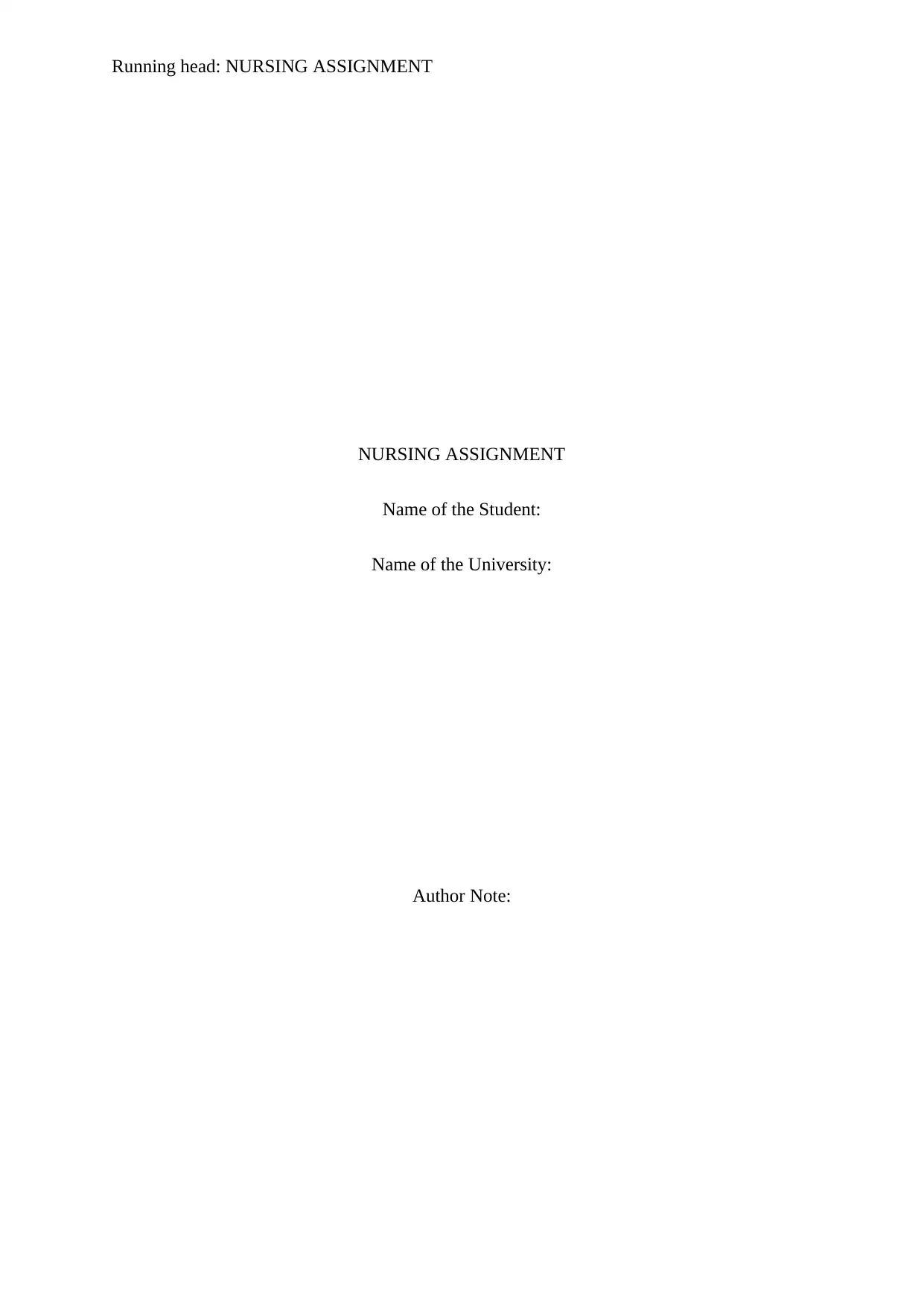
Running head: NURSING ASSIGNMENT
NURSING ASSIGNMENT
Name of the Student:
Name of the University:
Author Note:
NURSING ASSIGNMENT
Name of the Student:
Name of the University:
Author Note:
Paraphrase This Document
Need a fresh take? Get an instant paraphrase of this document with our AI Paraphraser

1NURSING ASSIGNMENT
Reflection has been considered to be a pivotal tool for nursing professionals to learn
from their clinical experience (Moon, 2013). To a great extent, reflection helps in the process
of self-assessment and at the same time also provides an opportunity to modify the faulty
elements in the course of professional practice (Paterson & Chapman, 2013). The provided
case study reports a series of documentation errors caused by a nursing professional. This
essay would critically reflect upon three important aspects which include, the identification of
instances of unprofessional practice, the impact on the corresponding professionals and
departments and the role of the hospital unit clerk with regard to the evaluation of the
unprofessional conduct.
Five critical incidences of unprofessional nursing conduct can be identified from the
provided case-study scenario. It should be mentioned here that the nurse missed out on
documenting appropriate nursing progress notes. The professional did not record the fact that
the patient had not been administered a dose of Septra. Further, it has also been stated that on
the following day, the nurse did not record the q4h vital signs as per the recommendation of
the physician. Hence, these instances can collectively be counted as the first incidence of
unprofessional nursing practice. The second instance can be identified as the incorrect
application of the VAC dressing to the patient by the nurse. The third instance can be
identified as the incorrect communication intimidated by the professional to the HCA. The
patient was supposed to undergo a surgery and was advised to be NPO. However, the nurse
informed the HCA to serve breakfast to the patient prior to the surgery. Moreover, the nurse
did not document on the pre-operative checklist that the patient has already been given
breakfast. The fourth instance can be explained as the inefficiency of the nursing
professional to apply correct dressing to the CVC line. At the same time, it should further be
mentioned that the nurse missed out on documenting the fact that the jugular CVC line had
been removed and proceeded with the removal of the CVC line at the incorrect time using an
Reflection has been considered to be a pivotal tool for nursing professionals to learn
from their clinical experience (Moon, 2013). To a great extent, reflection helps in the process
of self-assessment and at the same time also provides an opportunity to modify the faulty
elements in the course of professional practice (Paterson & Chapman, 2013). The provided
case study reports a series of documentation errors caused by a nursing professional. This
essay would critically reflect upon three important aspects which include, the identification of
instances of unprofessional practice, the impact on the corresponding professionals and
departments and the role of the hospital unit clerk with regard to the evaluation of the
unprofessional conduct.
Five critical incidences of unprofessional nursing conduct can be identified from the
provided case-study scenario. It should be mentioned here that the nurse missed out on
documenting appropriate nursing progress notes. The professional did not record the fact that
the patient had not been administered a dose of Septra. Further, it has also been stated that on
the following day, the nurse did not record the q4h vital signs as per the recommendation of
the physician. Hence, these instances can collectively be counted as the first incidence of
unprofessional nursing practice. The second instance can be identified as the incorrect
application of the VAC dressing to the patient by the nurse. The third instance can be
identified as the incorrect communication intimidated by the professional to the HCA. The
patient was supposed to undergo a surgery and was advised to be NPO. However, the nurse
informed the HCA to serve breakfast to the patient prior to the surgery. Moreover, the nurse
did not document on the pre-operative checklist that the patient has already been given
breakfast. The fourth instance can be explained as the inefficiency of the nursing
professional to apply correct dressing to the CVC line. At the same time, it should further be
mentioned that the nurse missed out on documenting the fact that the jugular CVC line had
been removed and proceeded with the removal of the CVC line at the incorrect time using an
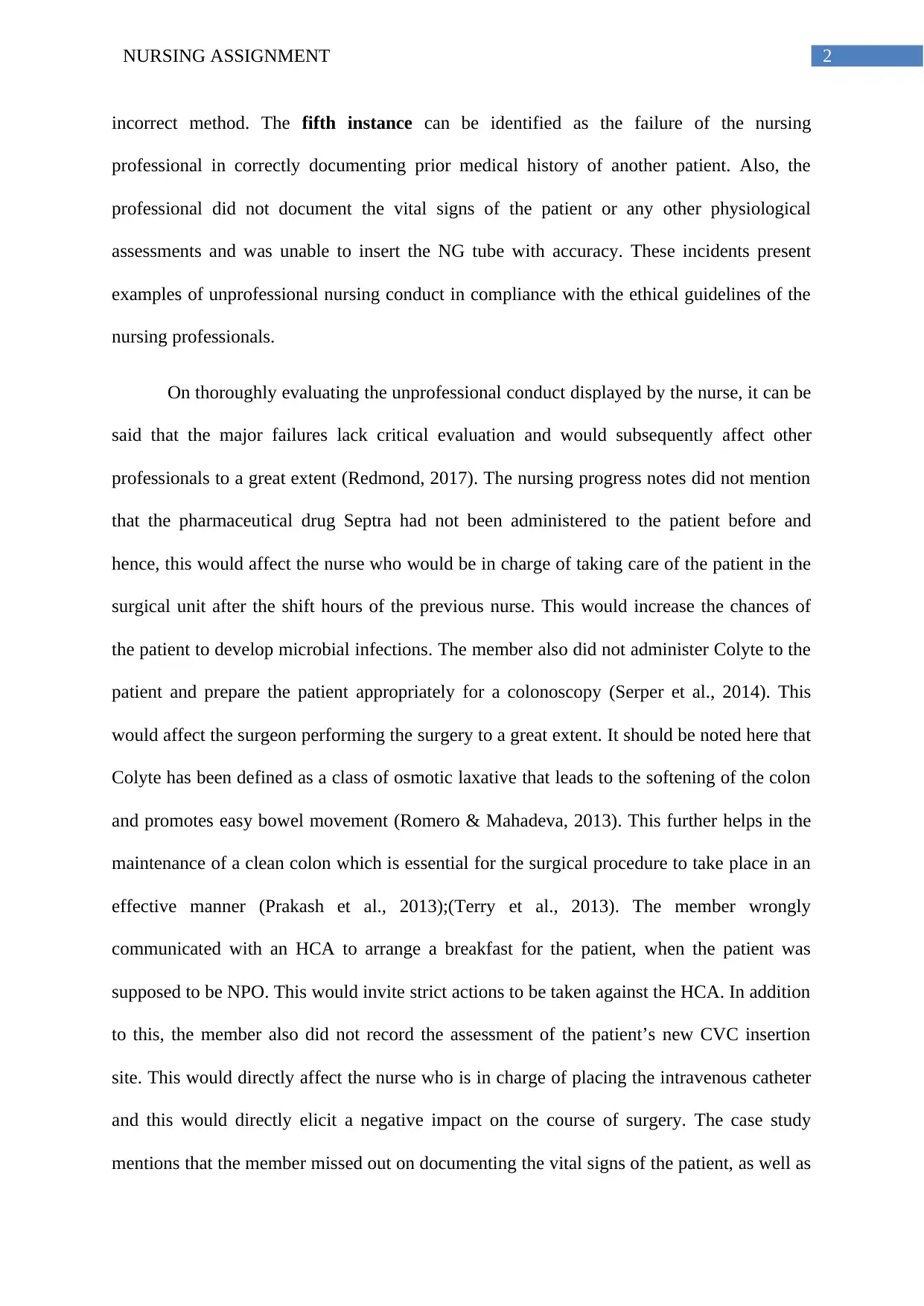
2NURSING ASSIGNMENT
incorrect method. The fifth instance can be identified as the failure of the nursing
professional in correctly documenting prior medical history of another patient. Also, the
professional did not document the vital signs of the patient or any other physiological
assessments and was unable to insert the NG tube with accuracy. These incidents present
examples of unprofessional nursing conduct in compliance with the ethical guidelines of the
nursing professionals.
On thoroughly evaluating the unprofessional conduct displayed by the nurse, it can be
said that the major failures lack critical evaluation and would subsequently affect other
professionals to a great extent (Redmond, 2017). The nursing progress notes did not mention
that the pharmaceutical drug Septra had not been administered to the patient before and
hence, this would affect the nurse who would be in charge of taking care of the patient in the
surgical unit after the shift hours of the previous nurse. This would increase the chances of
the patient to develop microbial infections. The member also did not administer Colyte to the
patient and prepare the patient appropriately for a colonoscopy (Serper et al., 2014). This
would affect the surgeon performing the surgery to a great extent. It should be noted here that
Colyte has been defined as a class of osmotic laxative that leads to the softening of the colon
and promotes easy bowel movement (Romero & Mahadeva, 2013). This further helps in the
maintenance of a clean colon which is essential for the surgical procedure to take place in an
effective manner (Prakash et al., 2013);(Terry et al., 2013). The member wrongly
communicated with an HCA to arrange a breakfast for the patient, when the patient was
supposed to be NPO. This would invite strict actions to be taken against the HCA. In addition
to this, the member also did not record the assessment of the patient’s new CVC insertion
site. This would directly affect the nurse who is in charge of placing the intravenous catheter
and this would directly elicit a negative impact on the course of surgery. The case study
mentions that the member missed out on documenting the vital signs of the patient, as well as
incorrect method. The fifth instance can be identified as the failure of the nursing
professional in correctly documenting prior medical history of another patient. Also, the
professional did not document the vital signs of the patient or any other physiological
assessments and was unable to insert the NG tube with accuracy. These incidents present
examples of unprofessional nursing conduct in compliance with the ethical guidelines of the
nursing professionals.
On thoroughly evaluating the unprofessional conduct displayed by the nurse, it can be
said that the major failures lack critical evaluation and would subsequently affect other
professionals to a great extent (Redmond, 2017). The nursing progress notes did not mention
that the pharmaceutical drug Septra had not been administered to the patient before and
hence, this would affect the nurse who would be in charge of taking care of the patient in the
surgical unit after the shift hours of the previous nurse. This would increase the chances of
the patient to develop microbial infections. The member also did not administer Colyte to the
patient and prepare the patient appropriately for a colonoscopy (Serper et al., 2014). This
would affect the surgeon performing the surgery to a great extent. It should be noted here that
Colyte has been defined as a class of osmotic laxative that leads to the softening of the colon
and promotes easy bowel movement (Romero & Mahadeva, 2013). This further helps in the
maintenance of a clean colon which is essential for the surgical procedure to take place in an
effective manner (Prakash et al., 2013);(Terry et al., 2013). The member wrongly
communicated with an HCA to arrange a breakfast for the patient, when the patient was
supposed to be NPO. This would invite strict actions to be taken against the HCA. In addition
to this, the member also did not record the assessment of the patient’s new CVC insertion
site. This would directly affect the nurse who is in charge of placing the intravenous catheter
and this would directly elicit a negative impact on the course of surgery. The case study
mentions that the member missed out on documenting the vital signs of the patient, as well as
⊘ This is a preview!⊘
Do you want full access?
Subscribe today to unlock all pages.

Trusted by 1+ million students worldwide
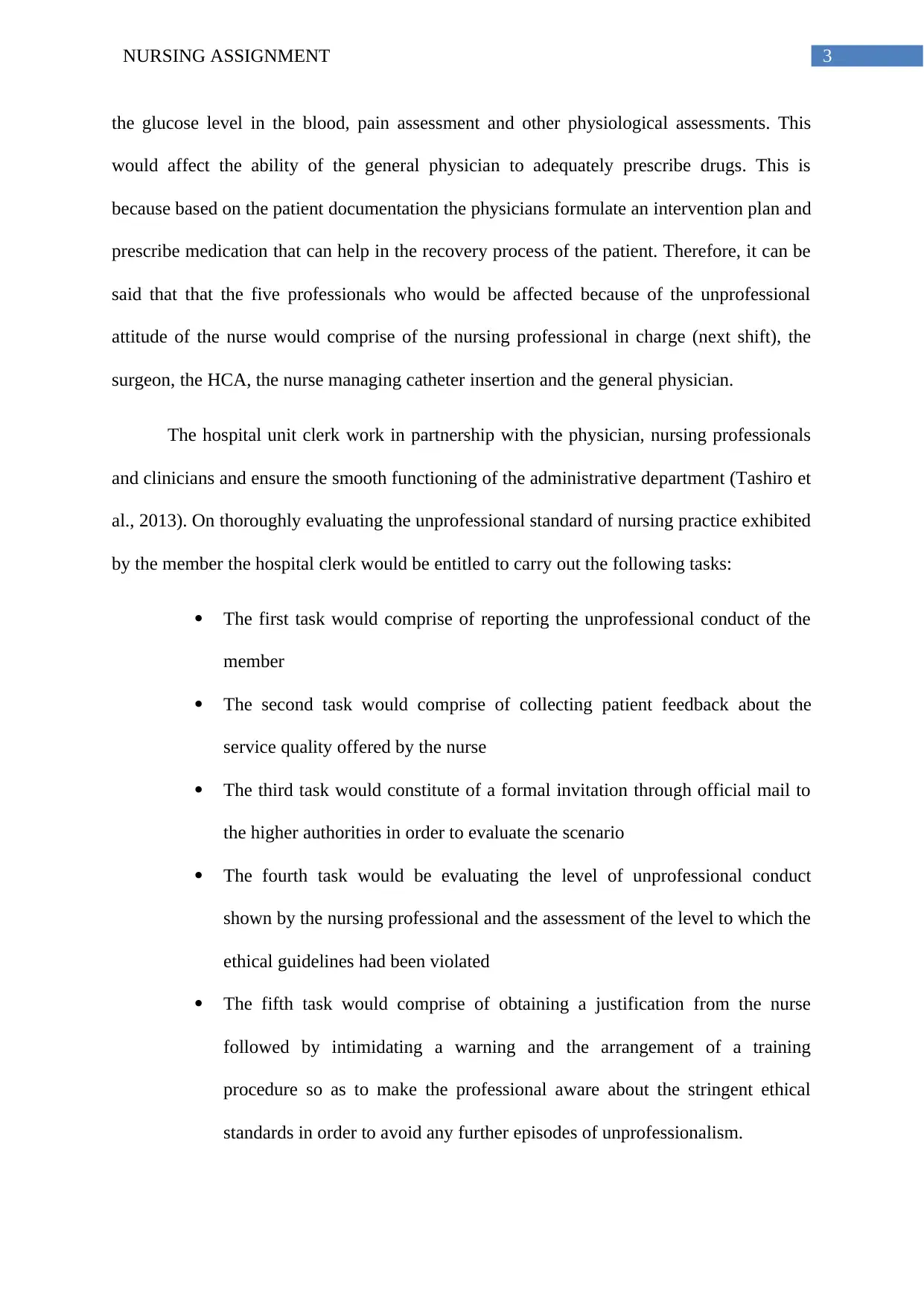
3NURSING ASSIGNMENT
the glucose level in the blood, pain assessment and other physiological assessments. This
would affect the ability of the general physician to adequately prescribe drugs. This is
because based on the patient documentation the physicians formulate an intervention plan and
prescribe medication that can help in the recovery process of the patient. Therefore, it can be
said that that the five professionals who would be affected because of the unprofessional
attitude of the nurse would comprise of the nursing professional in charge (next shift), the
surgeon, the HCA, the nurse managing catheter insertion and the general physician.
The hospital unit clerk work in partnership with the physician, nursing professionals
and clinicians and ensure the smooth functioning of the administrative department (Tashiro et
al., 2013). On thoroughly evaluating the unprofessional standard of nursing practice exhibited
by the member the hospital clerk would be entitled to carry out the following tasks:
The first task would comprise of reporting the unprofessional conduct of the
member
The second task would comprise of collecting patient feedback about the
service quality offered by the nurse
The third task would constitute of a formal invitation through official mail to
the higher authorities in order to evaluate the scenario
The fourth task would be evaluating the level of unprofessional conduct
shown by the nursing professional and the assessment of the level to which the
ethical guidelines had been violated
The fifth task would comprise of obtaining a justification from the nurse
followed by intimidating a warning and the arrangement of a training
procedure so as to make the professional aware about the stringent ethical
standards in order to avoid any further episodes of unprofessionalism.
the glucose level in the blood, pain assessment and other physiological assessments. This
would affect the ability of the general physician to adequately prescribe drugs. This is
because based on the patient documentation the physicians formulate an intervention plan and
prescribe medication that can help in the recovery process of the patient. Therefore, it can be
said that that the five professionals who would be affected because of the unprofessional
attitude of the nurse would comprise of the nursing professional in charge (next shift), the
surgeon, the HCA, the nurse managing catheter insertion and the general physician.
The hospital unit clerk work in partnership with the physician, nursing professionals
and clinicians and ensure the smooth functioning of the administrative department (Tashiro et
al., 2013). On thoroughly evaluating the unprofessional standard of nursing practice exhibited
by the member the hospital clerk would be entitled to carry out the following tasks:
The first task would comprise of reporting the unprofessional conduct of the
member
The second task would comprise of collecting patient feedback about the
service quality offered by the nurse
The third task would constitute of a formal invitation through official mail to
the higher authorities in order to evaluate the scenario
The fourth task would be evaluating the level of unprofessional conduct
shown by the nursing professional and the assessment of the level to which the
ethical guidelines had been violated
The fifth task would comprise of obtaining a justification from the nurse
followed by intimidating a warning and the arrangement of a training
procedure so as to make the professional aware about the stringent ethical
standards in order to avoid any further episodes of unprofessionalism.
Paraphrase This Document
Need a fresh take? Get an instant paraphrase of this document with our AI Paraphraser

4NURSING ASSIGNMENT
Hence, to conclude it can be said that complying with the ethical guidelines of the
nursing profession is extremely important. This helps in delivering quality services and
attaining positive patient outcomes.
Hence, to conclude it can be said that complying with the ethical guidelines of the
nursing profession is extremely important. This helps in delivering quality services and
attaining positive patient outcomes.
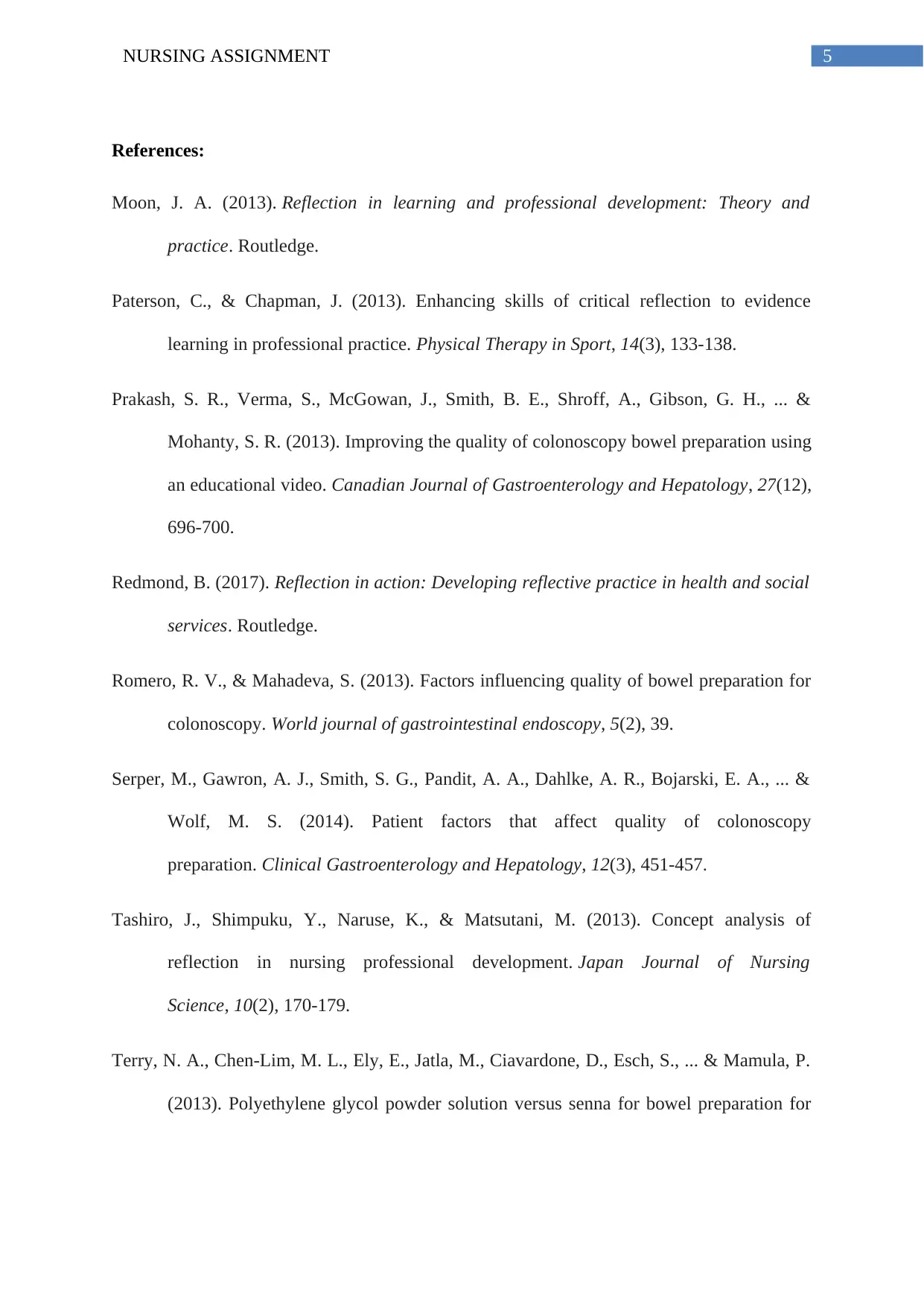
5NURSING ASSIGNMENT
References:
Moon, J. A. (2013). Reflection in learning and professional development: Theory and
practice. Routledge.
Paterson, C., & Chapman, J. (2013). Enhancing skills of critical reflection to evidence
learning in professional practice. Physical Therapy in Sport, 14(3), 133-138.
Prakash, S. R., Verma, S., McGowan, J., Smith, B. E., Shroff, A., Gibson, G. H., ... &
Mohanty, S. R. (2013). Improving the quality of colonoscopy bowel preparation using
an educational video. Canadian Journal of Gastroenterology and Hepatology, 27(12),
696-700.
Redmond, B. (2017). Reflection in action: Developing reflective practice in health and social
services. Routledge.
Romero, R. V., & Mahadeva, S. (2013). Factors influencing quality of bowel preparation for
colonoscopy. World journal of gastrointestinal endoscopy, 5(2), 39.
Serper, M., Gawron, A. J., Smith, S. G., Pandit, A. A., Dahlke, A. R., Bojarski, E. A., ... &
Wolf, M. S. (2014). Patient factors that affect quality of colonoscopy
preparation. Clinical Gastroenterology and Hepatology, 12(3), 451-457.
Tashiro, J., Shimpuku, Y., Naruse, K., & Matsutani, M. (2013). Concept analysis of
reflection in nursing professional development. Japan Journal of Nursing
Science, 10(2), 170-179.
Terry, N. A., Chen-Lim, M. L., Ely, E., Jatla, M., Ciavardone, D., Esch, S., ... & Mamula, P.
(2013). Polyethylene glycol powder solution versus senna for bowel preparation for
References:
Moon, J. A. (2013). Reflection in learning and professional development: Theory and
practice. Routledge.
Paterson, C., & Chapman, J. (2013). Enhancing skills of critical reflection to evidence
learning in professional practice. Physical Therapy in Sport, 14(3), 133-138.
Prakash, S. R., Verma, S., McGowan, J., Smith, B. E., Shroff, A., Gibson, G. H., ... &
Mohanty, S. R. (2013). Improving the quality of colonoscopy bowel preparation using
an educational video. Canadian Journal of Gastroenterology and Hepatology, 27(12),
696-700.
Redmond, B. (2017). Reflection in action: Developing reflective practice in health and social
services. Routledge.
Romero, R. V., & Mahadeva, S. (2013). Factors influencing quality of bowel preparation for
colonoscopy. World journal of gastrointestinal endoscopy, 5(2), 39.
Serper, M., Gawron, A. J., Smith, S. G., Pandit, A. A., Dahlke, A. R., Bojarski, E. A., ... &
Wolf, M. S. (2014). Patient factors that affect quality of colonoscopy
preparation. Clinical Gastroenterology and Hepatology, 12(3), 451-457.
Tashiro, J., Shimpuku, Y., Naruse, K., & Matsutani, M. (2013). Concept analysis of
reflection in nursing professional development. Japan Journal of Nursing
Science, 10(2), 170-179.
Terry, N. A., Chen-Lim, M. L., Ely, E., Jatla, M., Ciavardone, D., Esch, S., ... & Mamula, P.
(2013). Polyethylene glycol powder solution versus senna for bowel preparation for
⊘ This is a preview!⊘
Do you want full access?
Subscribe today to unlock all pages.

Trusted by 1+ million students worldwide
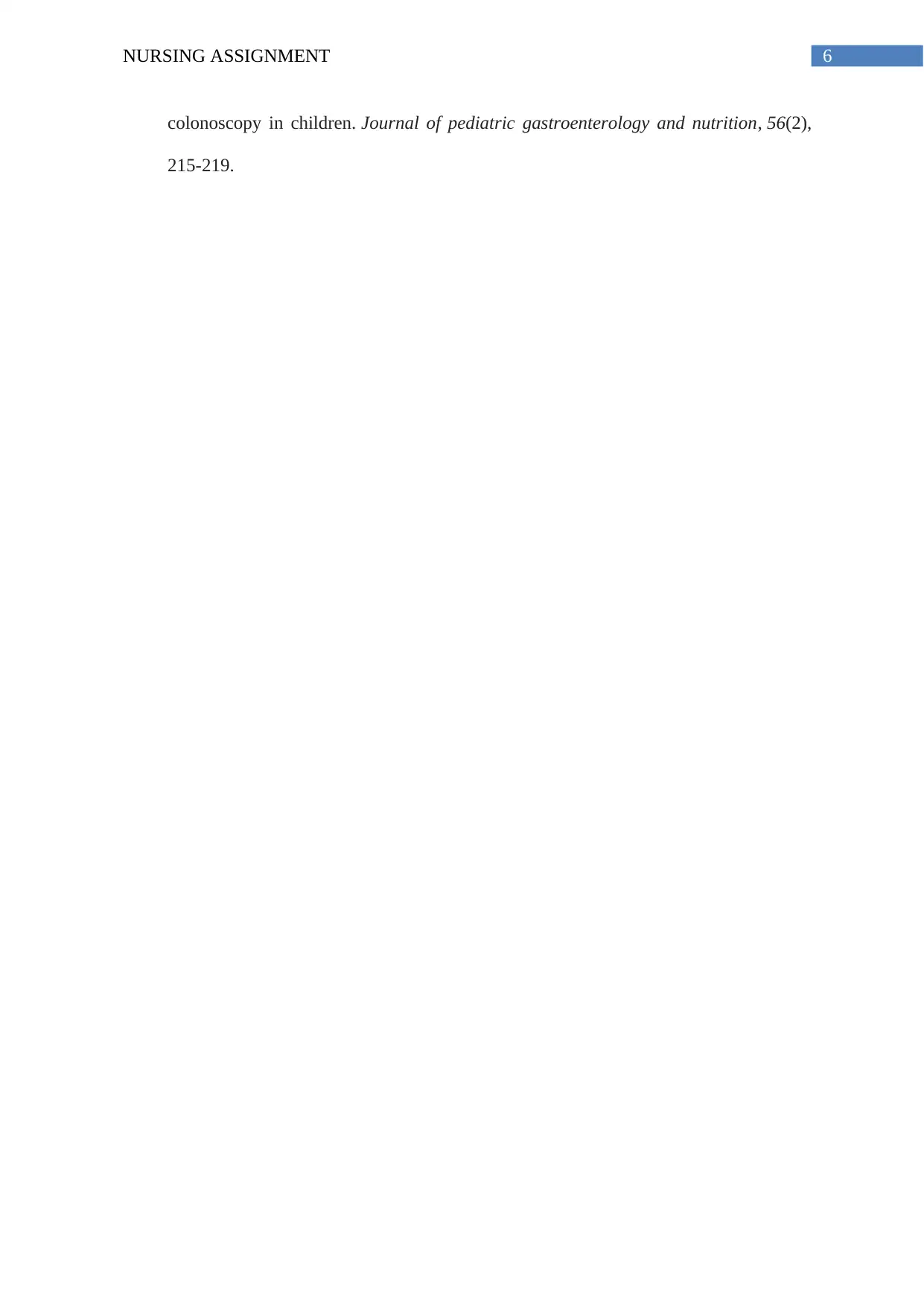
6NURSING ASSIGNMENT
colonoscopy in children. Journal of pediatric gastroenterology and nutrition, 56(2),
215-219.
colonoscopy in children. Journal of pediatric gastroenterology and nutrition, 56(2),
215-219.
1 out of 7
Related Documents
Your All-in-One AI-Powered Toolkit for Academic Success.
+13062052269
info@desklib.com
Available 24*7 on WhatsApp / Email
![[object Object]](/_next/static/media/star-bottom.7253800d.svg)
Unlock your academic potential
Copyright © 2020–2025 A2Z Services. All Rights Reserved. Developed and managed by ZUCOL.





